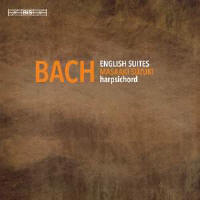Texte paru dans: / Appeared in: |
|
|
Reviewer: Jerry
Dubins With this release, Masaaki Suzuki is nearing completion of his survey of Bach’s major oeuvre for solo harpsichord. We’ve already had his Partitas and French Suites, both books of The Well-Tempered Clavier, the Goldberg Variations, the Inventions and Sinfonias, the Italian Concerto and French Overture which comprise the Clavier-Übung II, and a disc of fantasias and fugues. But for a miscellany of smaller, stand-alone pieces scattered throughout Bach’s catalog, the only major works left I can think of that Suzuki hasn’t gotten around to yet are the seven Toccatas.
1) They are the earliest of Bach’s three sets of suites to be written, likely around 1715 during the composer’s time in Weimar. 2) Bach didn’t call the suites “English.” That title can probably be traced to Johann Nikolaus Forkel, who suggested that the works may (emphasis on “may”) have been “made for an Englishman of rank.” 3) There is nothing “English” about the English Suites. In style (emphasis on “style”), they differ little from the French Suites that came into being between 1722 and 1725. 4) In form, however, the English Suites differ from their more modestly sized French sisters in that they are on a grander scale, each beginning with a Prelude, followed by a sequence of dance movements displaying Bach’s contrapuntal ingenuity. The French Suites, by contrast, not only lack Preludes, they tend to “avoid the use of counterpoint, focusing more keenly on the exploration of such galant elements as cantabile melodies and sonorous, idiomatic keyboard textures.” In this regard, the English Suites are closer to their later big-brother Partitas, which came last between 1725 and 1730–31.
In 37:1, reviewing Ketil
Haugsand’s Simax recording of the English Suites, Raymond Tuttle made
an admission with which I find myself nodding my head in agreement. Wrote
Tuttle, “I’ve found that my reaction to harpsichord discs probably depends
as much on the instrument as it does on the performer.” My sense of Suzuki’s
English Suites is that they’re better than they sound. Built in 1982
by Utrecht maker Willem Kroesbergen, the harpsichord is modeled after an
enlarged Ruckers. The sound of it, however, is anything but enlarged.
Throughout, it sounds damped or woolly, as if a pedal or lever that stifles
the soundboard is permanently engaged. Necessarily, this works against
Suzuki’s delineation of voices, which is so crucial in Bach’s contrapuntal
textures. It also defeats any attempts Suzuki makes at achieving contrasts
in the tonal coloration, with the result being a blandness in the sound,
which I don’t believe is what Suzuki intended. His execution and phrasing,
which are not affected by the instrument’s swaddling-in-a-blanket effect,
tells me that Suzuki’s technique is as secure as ever, and that his musical
instincts run deep, which is not surprising for someone who has immersed
himself in Bach to the extent that Suzuki has.
| |
|
|
|
|
|
|
|
Cliquez l'un ou l'autre
bouton pour découvrir bien d'autres critiques de CD |
|




